The 200 square meter LED-research facility is the result of a partnership with LED-supplier Phillips and greenhouse manufacturer Cambridge HOK. The primary aim is to deliver applied research and technology transfer to growers, using this applied R&D facility for multilayer cropping using LED lights.
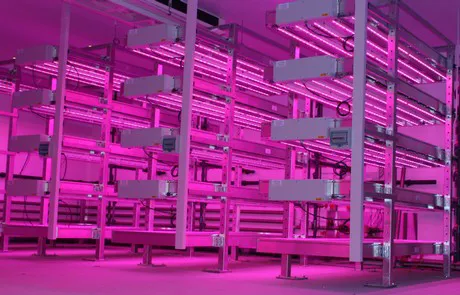
The LED-research facility is located in one of 50 greenhouse compartments on the 200 acre research site. McPherson: "The original, and ideal, aim was to build a new warehouse on a vacant plot land in the glasshouse complex here at STC as this would have allowed us to also install PV (solar) panels , but the cost of this ambitious plan was a little too high for the initial level of investment available so we scaled back the plan slightly and instead converted an existing greenhouse into a LED-research facility."
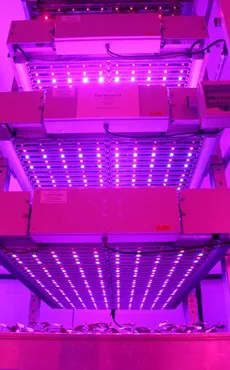 Eventually Cambridge HOK used 80-100 mm Kingspan panels to insulate an existing glasshouse, leaving an identical glasshouse compartment next door for comparative trialling. After the retrospective fitting of the greenhouse, Cambridge HOK further designed and installed a range of multi-tier benches using an ebb & flood irrigation system; all under full computer control. Cambridge HOK also fitted the Phillips LED-luminaires which comprise a mixture of research modules (which are dimmable to allow light recipe development) and Greenpower production modules.
Eventually Cambridge HOK used 80-100 mm Kingspan panels to insulate an existing glasshouse, leaving an identical glasshouse compartment next door for comparative trialling. After the retrospective fitting of the greenhouse, Cambridge HOK further designed and installed a range of multi-tier benches using an ebb & flood irrigation system; all under full computer control. Cambridge HOK also fitted the Phillips LED-luminaires which comprise a mixture of research modules (which are dimmable to allow light recipe development) and Greenpower production modules."There are 4 research module racks each 2m x 1.2m in dimension with 4-6 tiers/rack (16 tiers in total) and up to 8 production module racks for crop production trialling (42 crop layers in total)", said McPherson. "We can regulate and dim each layer of crop on a tier by tier basis in the research modules and modify the daylength in the production modules. Each bench has got its own IP address and is completely trackable by the computer for detailed data analysis, including energy use.
Regarding the heat that comes off the back of the light interface, so far McPherson hasn’t observed any heat-problems in the rooting of the crops being grown. "We get a bit of root-zone warming of course, but we certainly don’t appear to have any issues with roots getting too hot. The installation includes an ebb & flood irrigation system and this provides regular cooling but we will continue to monitor this in controlled experiments to get a better overview on this."
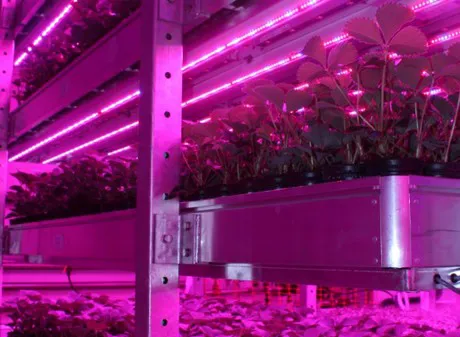
So far the initial crops, which include leafy salad crops, herbs, ornamentals and various propagated crops, are doing very well in the LEDS4CROPS facility. "We started off 3-4 months ago and the initial results are really encouraging though, as the majority of studies are being funded privately, we are not able to divulge details of the work due to confidentiality arrangements.
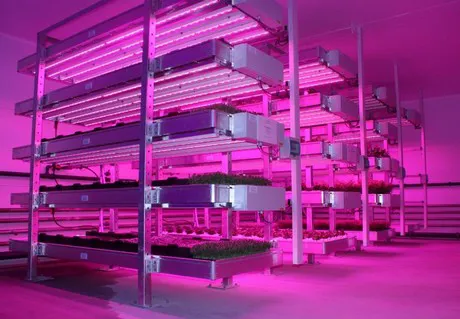
According to Martin McPherson, the industry is not far off the right timing in terms of commercial application of LED-growing lights. "The fact that there are already some growers in various Member States & beyond picking up the technology early is a promising sign and, as competition in the LED market increases, this will further impact on prices to encourage investment, he said. He also noted though that ‘the cheapest isn’t always the best’. "As an industry-owned applied science group, our primary remit is to evaluate the technology on behalf of the industry to demonstrate its potential. Clearly the development of the LED4CROPS facility provides us with the potential to create light recipes for a wide range of different crops and to better understand plant responses to light. The recent appointment of Dr Phillip Davis as an applied photobiologist at STC (with funding from the Horticultural Fellowship Group) and support from Lancaster University is testament to this industry ambition."
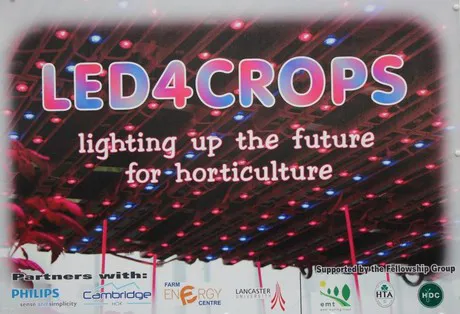
"People have had ideas of vertical farming in the past, but these were always limited by light. And now, suddenly there is a cool light source, with low energy use. There is a lot of research to be done, but the possibilities with this application seems infinite. We can't answer all the questions immediately, but we have created a facility which will kick-start people into thinking about it and allow them to consider exploring the full potential that this new technology offers."
For more information:
Stockbridge Technology Centre
Cawood
Selby
North Yorkshire
YO8 3TZ
Telephone : +44(0) 1757 268275
Fax.: +44(0) 1757 268996
http://stc-nyorks.co.uk/
enquiries@stc-nyorks.co.uk
Philips Horticultural Lighting
Boschdijk 525
PB 90050, 5
600 PB
Eindhoven
The Netherlands
horti.info@philips.com
www.philips.com/horti
Victor Lambert
CambridgeHOK
Tel: +44 1430 449440
vlambert@cambridgehok.co.uk
www.cambridgehok.co.uk
